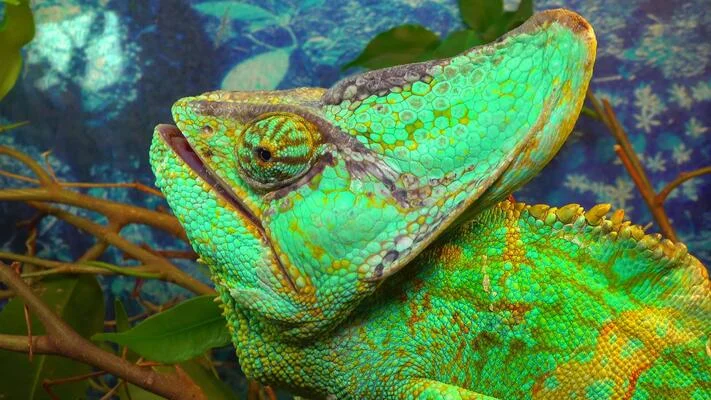Chameleons are among the most intriguing reptiles on Earth. The family Chamaeleonidae, commonly known in Slovak/Czech as chameleónovité, encompasses a diversity of species that have evolved remarkable adaptations — from independently swiveling eyes and projectile tongues to dramatic color shifts and arboreal specialization. In this article, we’ll explore everything you need to know about this captivating family: their classification, anatomy, behavior, ecology, conservation, and more.
What Are Chameleónovité (Chamaeleonidae)?
The word “chameleon” comes from the Greek χαμαιλέων / khamaileōn (“ground lion”) — an evocative name for a creature that can stealthily cling to branches yet dominate its small world.
The family Chamaeleonidae is a group of mostly arboreal (tree-dwelling) lizards, native to the Old World (i.e. Africa, Madagascar, southern Europe, parts of Asia).
Key general traits of chameleónovité include:
- Laterally compressed bodies (flattened from side to side), making them narrow in profile.
- Zygodactylous feet: toes fused into two opposing groups (for grasping thin branches).
- Prehensile tail in most species, acting like a fifth limb to anchor to branches.
- Independently moving eyes, often offering nearly 360° vision.
- Projectile tongue specialized for capturing prey from a distanc.
- Color change capabilities (though in varying degrees among species).
There are over 150–200 species described in the family (some sources list ~202) as taxonomic revisions continue.
Chameleónovité are a distinct and highly specialized lineage of iguanian lizards (Iguania) in the order Squamata.
Taxonomy & Evolutionary History
Classification and Subfamilies
Historically, chameleónovité were divided into two subfamilies: Brookesiinae (pygmy or dwarf chameleons) and Chamaeleoninae (larger, more “typical” chameleons).
Brookesiinae: Includes genera such as Brookesia, Palleon (and sometimes Rieppeleon). These are often ground-dwelling or small forest-floor chameleons, many endemic to Madagascar.
Chamaeleoninae: Contains genera like Chamaeleo, Calumma, Furcifer, Trioceros, Kinyongia, Bradypodion. These tend to be arboreal and exhibit more pronounced morphological specializations.
However, phylogenetic studies suggest that Brookesiinae may not form a natural (monophyletic) group, so modern taxonomic treatments sometimes avoid strict subfamily divisions.
Evolution and Fossil Record
Fossil chameleons date back to the Early Miocene, though molecular estimates suggest even earlier origins (e.g., Paleocene) for the broader group.
Chameleons underwent major radiations especially in Madagascar and Africa, leading to high species diversity in these areas.
Over time, different lineages evolved morphological adaptations suited for particular niches (forest canopy, dry scrub, montane habitats) — leading to the great diversity of forms we see today.
Geographic Distribution and Biogeography
Chameleónovité are found across a broad but discontinuous range:
- Madagascar: by far the richest center of diversity. Many genera and many endemic species are found only on Madagascar.
- Sub-Saharan Africa: a major center, with both widespread and localized species.
- Southern Europe & the Mediterranean: a few species, e.g. Chamaeleo chamaeleon in southern Europe, North Africa, and the Mediterranean.
- Asia: limited presence — for instance in southern India and Sri Lanka (Chamaeleo zeylanicus) and parts of the Middle East.
- Introduced populations: in places like Florida, Hawaii, etc.
Their habitat spans from rainforests to arid deserts, from lowlands to mountainous regions.
This wide, but patchy, distribution is the result of both ancient dispersal events and vicariance (geographic fragmentation) linked to continental drift, climate change, and ecological specialization.
Morphology & Anatomy: What Makes a Chameleon “A Chameleon”?
Body Shape & Limbs
Chameleónovité have bodies compressed laterally (flattened side to side). This helps them maneuver and hide among branches without presenting much silhouette to predators.
Their feet are zygodactylous — toes fused into two opposing groups (2 + 3 or 3 + 2) which function like miniature grasping hands adapted for holding thin twigs.
Most chameleons have a prehensile tail, used to wrap around branches and stabilize themselves. The tail is a critical “fifth limb.”
Skin, Scales & Color Change
One of the most iconic features is color change. But how exactly do they do it?
Chameleons’ skin comprises multiple layers:
- Epidermis (outer skin)
- Chromatophore layers (pigment cells like xanthophores, erythrophores)
- Iridophore / guanine crystal layers
- Deeper reflecting / structural layers
Color shifts occur by actively tuning the spacing or orientation of guanine nanocrystals in the iridophore layer (so-called s-iridophores). Changing the lattice spacing alters which wavelengths of light are reflected, thus changing apparent color.
Notably:
- Chameleons don’t fully match any arbitrary background; they only display colors within their physiological repertoire.
- Color change is often associated with mood, temperature, social signaling, stress — not purely camouflage.
Other morphological features often seen:
- Crests, horns, casques (helmet-like structures) on heads — more prominent in males in some species.
- In many species, the body surface is ornamented with ridges, tubercles, flaps.
- Acrodont dentition (teeth attached to the crest of the jawbone) rather than pleurodont.
Vision & Sensory Systems
Chameleon eyes are among the most specialized in reptiles:
- Independently mobile eyes: Each eye can move separately, giving a full field of view without moving the head.
- When focusing on prey, the eyes align to produce stereoscopic vision (depth perception).
- The lens can change its shape rapidly, giving them excellent focusing ability — much like a camera lens.
Hearing in chameleons is limited — they do not have external ears but can detect vibrations and low-frequency sounds.
Tongue & Feeding Mechanics
Arguably one of the most astonishing adaptations is the projectile tongue:
- The tongue can extend to distances greater than their body length in some species.
- A special accelerator muscle and hydrostatic pressure system generate rapid extension.
- The tongue tip is sticky, capturing prey upon contact, then retracting the prey into the mouth.
Reproduction & Development
Most chameleon species are oviparous (lay eggs), though a few are viviparous / ovoviviparous (live birth or brooding eggs internally).
Typical reproductive traits:
- Females dig nests (in substrate) to deposit eggs.
- Clutch size varies widely depending on species (some lay relatively few eggs, others many).
- Incubation periods can be months (depending on temperature, species).
- Sexual dimorphism is common: males often larger and more ornamented (horns, crests).
- In some species, female becomes larger than the male (especially among dwarf species).
Ecology, Behavior & Life History
Habitat & Microhabitat Use
Chameleónovité are mainly arboreal, favoring bushes, trees, forest canopy, shrubs — places where their gripping feet, prehensile tails, and camouflage matter most.
Some species are terrestrial or semi-terrestrial, especially among the pygmy/dwarf forms (e.g. Brookesia) which live near leaf litter or forest floor.
They are found across a variety of ecological zones — humid rainforest, dry deciduous forest, scrubland, savanna, even semi-desert edges.
Feeding & Diet
Chameleónovité are primarily insectivorous, feeding on a variety of insects (crickets, grasshoppers, flies, beetles) and other small invertebrates.
Larger species may also take small vertebrates (e.g. small birds or lizards) opportunistically.
Feeding strategy is usually sit-and-wait or slow stalking, relying on stealth and accurate shooting of the tongue rather than active pursuit.
Movement & Locomotion
Chameleons often move slowly and deliberately, with a swaying gait that mimics foliage motion (helping to remain inconspicuous).
They rely on gripping feet, the tail, and balance rather than speed for moving through complex branch networks.
Social Behavior and Signaling
Chameleons are typically solitary animals. Sight‐based encounters between individuals often trigger social displays. Color change plays a critical role in communication: dominance, submission, mating status, aggression, stress signals. Display behaviors may include head bobbing, body inflation, throat extension, changing color contrast, etc.
Representative & Notable Species
Here are some well-known or particularly interesting species from the chameleon family:
Veiled Chameleon (Chamaeleo calyptratus)
Native to Yemen and Saudi Arabia, this species is popular in the pet trade. It has a distinctive casque (helmet) on its head, which helps capture dew to drink (water trickles into its mouth).
Males live ~8 years in captivity; females ~5.
They breed multiple clutches per year; each clutch may contain 20–70 eggs.
Parson’s Chameleon (Calumma parsonii)
One of the largest chameleon species, endemic to Madagascar.
They are slow-breeding and long-lived — in captivity, some reach 14 years or more.
Their main threats include habitat loss and overcollection in the pet trade. They are listed as Near Threatened.
Four-horned Chameleon (Trioceros quadricornis)
Found in highland areas of western Cameroon and Nigeria. As the name suggests, it bears four horns on its head (two on each side).
Marshall’s Pygmy Chameleon (Rhampholeon marshalli)
A small species native to forested regions in Zimbabwe and Mozambique. It ≈ 3.5 cm in snout-vent length and has cryptic leaf-like appearance.
This chameleon mimics a leaf when motionless. Its populations face habitat fragmentation threats.
Common Chameleon (Chamaeleo chamaeleon)
This species occurs in southern Europe, North Africa, and parts of the Middle East. It is one of the few chameleons found in Europe.
Threats, Conservation & Human Impact
Major Threats
Habitat loss and deforestation
Many chameleon species depend on forest environments, which are under pressure from agriculture, logging, urbanization.
Illegal and over-collection for the pet trade
Some species, especially rare ones, are in demand in exotic pet markets, which can decimate wild populations.
Fragmentation and small population sizes
Many species are restricted to small geographic ranges, making them vulnerable to stochastic events.
Climate change
Altered temperature and precipitation regimes can impact habitat suitability and the delicate physiology of chameleons.
Predation, disease, invasive species
Eggs and juveniles are vulnerable to ants and other invertebrates, birds, snakes.
Conservation Initiatives & Legal Protections
Many chameleon species are listed under CITES (Appendix II or Appendix I for the most threatened), regulating international trade. For example, Calumma parsonii is under CITES Appendix II. Protected areas, reserves, habitat restoration are essential to safeguard populations. Captive breeding programs can reduce wild harvest pressure. Research and monitoring are necessary to understand population trends, ecology, and threats.
Examples of Conservation Challenges
The slow reproductive rate and long lifespan of species like Parson’s chameleon mean that population declines recover slowly. Some species survive only in fragmented habitat patches; corridors to connect habitats are imperative. Enforcement of wildlife trade regulations is often weak in source countries.
Chameleónovité in Captivity: Keeping Them as Pets
Chameleons attract hobbyists due to their exotic appearance and color-changing ability. But they are not easy pets — they require specialized care.
Housing & Enclosure Needs
- Vertical, tall cages (to allow climbing) with ample branches, foliage, hiding spots.
- Ventilation is crucial (many species require flow-through air).
- Lighting that includes UVB to support vitamin D3 and calcium metabolism.
- Proper temperature gradient (basking spot + cooler areas) and humidity control.
- Misting systems or drip lines to provide water (many species drink from droplets).
Diet & Nutrition
- Insects (crickets, roaches, etc.), gut-loaded (nutrient-rich) before feeding.
- Occasional supplementation with vitamin / calcium powders (especially for captive animals).
- Some species may accept plant matter (flowers, leaves) but insectivory is the main diet.
Health and Common Issues
- Metabolic bone disease (due to calcium/UVB deficiency) is a frequent problem.
- Stress, dehydration, poor husbandry can lead to lethargy, failure to feed, illness.
- Regular veterinary checkups with a reptile specialist.
Ethical & Conservation Considerations
- Avoid purchasing wild-caught specimens unless they are legally and ethically sourced.
- Support reputable breeders and captive-bred stock.
- Be aware of the legal status of a species in your country (permits, import restrictions).
Future Directions & Research
The study of chameleon biology continues to yield new insights and applications:
- Bio-inspired color change: Researchers are looking at how chameleon skin mechanisms could inspire smart materials and adaptive camouflage in textiles or robotics.
- Phylogenetic and genomic research: Unraveling the evolutionary relationships among chameleon lineages, clarifying taxonomy, exploring speciation.
- Climate change impact studies: Modeling how species distributions might shift under changing climates, and identifying conservation priorities.
- Ecological interactions: Better understanding of predator-prey interactions, competition, ecological roles in insect control.
- Conservation interventions: More captive breeding, reintroductions, habitat corridors, community-based conservation.
Conclusion
The chameleónovité (Chamaeleonidae) represent one of nature’s most specialized, fascinating lineages of reptiles. Their adaptations — from color change and independently mobile eyes, to grasping limbs and extendable tongues — are marvels of evolutionary innovation. However, many species face severe threats from habitat destruction, climate change, and overcollection. Conservation, informed husbandry practices, and ongoing research are essential to ensure that these breathtaking reptiles continue to grace our planet.
If you ever gaze at a chameleon blending into a leaf or projecting its tongue at lightning speed, know that behind that moment lies millions of years of evolutionary fine-tuning, adaptation, and survival.
Frequently Asked Questions (FAQs)
1. Can all chameleons change color?
Yes — though the range and extent of color change varies among species. Some change only brightness, others show vibrant hues. Chameleons cannot mimic arbitrary patterns (e.g. polka dots) beyond their physiological limits
2. Why do chameleons change color?
Not solely for camouflage. Color change is used for communication (territorial displays, mating signals), mood, thermoregulation, stress responses, and sometimes as a defensive measure.
3. How far can a chameleon’s tongue shoot?
In many species, the tongue can extend a distance greater than the chameleon’s body length, using rapid muscle contraction and hydrostatic mechanisms.
4. Are chameleons good pets for beginners?
They are generally considered advanced or intermediate reptile pets due to their specialized needs (lighting, humidity, diet, housing). Beginners should thoroughly research species-specific care.
5. Which regions have the highest chameleon diversity?
Madagascar is the richest hotspot for chameleon diversity, followed by sub-Saharan Africa. These regions host many endemic genera and species.








